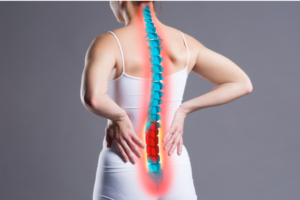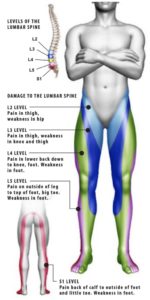Sciatica: What it is, Causes, Symptoms, Treatments
Welcome to the NJ Pain & Spine blog, where we delve into the intricate world of pain management and relief. This edition highlights a common yet often misunderstood condition: Sciatica. Sciatica, characterized by pain along the sciatic nerve, can be a daunting challenge for those grappling with sharp pain/numbness shooting down your lower back, buttocks, and down the back of your legs. Whether exploring diagnosis, seeking back pain relief, or understanding nerve pain, this guide empowers and educates on Sciatica.

What is Sciatica?
Sciatica, often mistaken for conventional back pain, manifests as pain along the sciatic nerve’s path, extending from the buttocks down each leg. Typically triggered by lumbar spine nerve root pressure, often due to a herniated disc or bone overgrowth, it induces inflammation, pain, and numbness in the affected leg. This condition is clinically defined as lumbar radiculopathy, emphasizing the pain, numbness, tingling, or weakness resulting from nerve compression in the lower back.
Furthermore, it’s crucial to differentiate sciatica from piriformis syndrome, a common point of confusion. While a herniated disc or spinal stenosis can prompt sciatica, piriformis syndrome involves the piriformis muscle exerting pressure on a specific area of the sciatic nerve in the buttock.
Symptoms of Sciatica
Sciatica exhibits a spectrum of symptoms, with pain along the nerve pathway, commonly traversing from the lower back to the buttock, thigh, and calf. Understanding the intricate nature of sciatica necessitates recognizing potential nerve root injuries along the lumbar spine. These injuries may occur at various vertebrae levels, each manifesting distinct symptoms. For instance, an injury at the L2 level may lead to thigh pain and hip weakness, while an L3 level injury can result in thigh pain and thigh and knee weakness. As the damage progresses through L4 to L5 and S1 levels, the associated pain and weakness patterns evolve, underscoring the nuanced nature of sciatica’s impact on different parts of the body.
 Causes of Sciatica
Causes of Sciatica
Sciatica, affecting a diverse demographic, can arise from various causes. Particularly, the most prevalent is wear and tear on spinal discs and abrupt pressure changes. A herniated disc, marked by the rupture of the outer disc wall and the bulging of the soft nucleus, often exerts harmful pressure on nerve roots, a common precursor to sciatic nerve pain. Additionally, degenerative disc disease, characterized by weakened spinal discs allowing vertebral bones to shift and pinch nerve roots, and spinal stenosis, where degeneration leads to bony spurs pressing into the spinal canal, are frequent contributors to the development of sciatica. These factors collectively underscore the multifaceted nature of sciatic nerve pain, often associated with aging, pregnancy, or prior physical trauma.
Self-Treatments
For milder cases of sciatica, self-treatment can be effective, focusing on reducing pain and discomfort. Cold or ice packs can be applied during the initial days to alleviate pain and swelling, then transition to a heating pad or warm compress. Over-the-counter NSAIDs can help manage pain, swelling, and inflammation. Additionally, incorporating stretches and activities under the guidance of an experienced instructor is crucial. Sciatica-specific stretches targeting the piriformis muscle and hamstrings can be beneficial. Recommended exercises include trunk rotations, planks for core strength, and certain yoga poses. You can find detailed instructions for these stretches and exercises here.
However, professional medical care is essential for cases involving moderate to severe pain, numbness, tingling, or muscle weakness, and self-treatment should be avoided.
Conservative Treatments
- Prescription Medications:
- Painkillers, muscle relaxers, and other medications can alleviate sciatica symptoms.
- Tricyclic antidepressants and anti-seizure medications may be prescribed for chronic or nerve-based pain.
- Physical Therapy:
- Focuses on exercises that reduce sciatica by alleviating pressure on the nerve.
- Includes stretching exercises and low-impact activities like walking, swimming, or water aerobics.
- Spinal Injections:
- Transforaminal Epidural Injection is an outpatient procedure involving an injection of a steroid-anesthetic medication. It aims to reduce swelling and inflammation of irritated spinal nerves. This injection provides temporary relief, allowing individuals to resume activities and continue with other treatments.
- Lumbar Epidural Steroid Injection (Lumbar ESI) administers anti-inflammatory medicine, typically a steroid or corticosteroid, into the epidural space around the spinal nerves in the lower back. It primarily manages chronic pain caused by irritation and inflammation of the spinal nerve roots in the lumbar region.
- Spinal Cord Stimulator:
- Individuals with persistent post-surgery back pain (failed back syndrome) or those seeking an alternative to surgery.
- A device with wire electrodes and a small battery is placed between the spinal cord and vertebrae, allowing the patient to use a remote control to send electrical impulses and immediately alleviate pain.
- Alternative Therapies:
- Chiropractic spine adjustments, yoga, acupuncture, and biofeedback are increasingly popular alternative treatments.
- Massage therapy can address muscle spasms associated with sciatica.
- Biofeedback, an alternative medicine approach, teaches individuals to change their body’s functioning, promoting physical and mental health.
Understanding sciatica is paramount for navigating its complexities and seeking effective relief. The diverse array of approaches ensures a tailored approach to managing this often challenging condition, from self-treatment methods to conservative medical interventions. Whether through personalized exercises, spinal injections, or alternative therapies, the journey to alleviating sciatic pain is as unique as the individuals it affects, emphasizing the importance of comprehensive care and informed decision-making.




